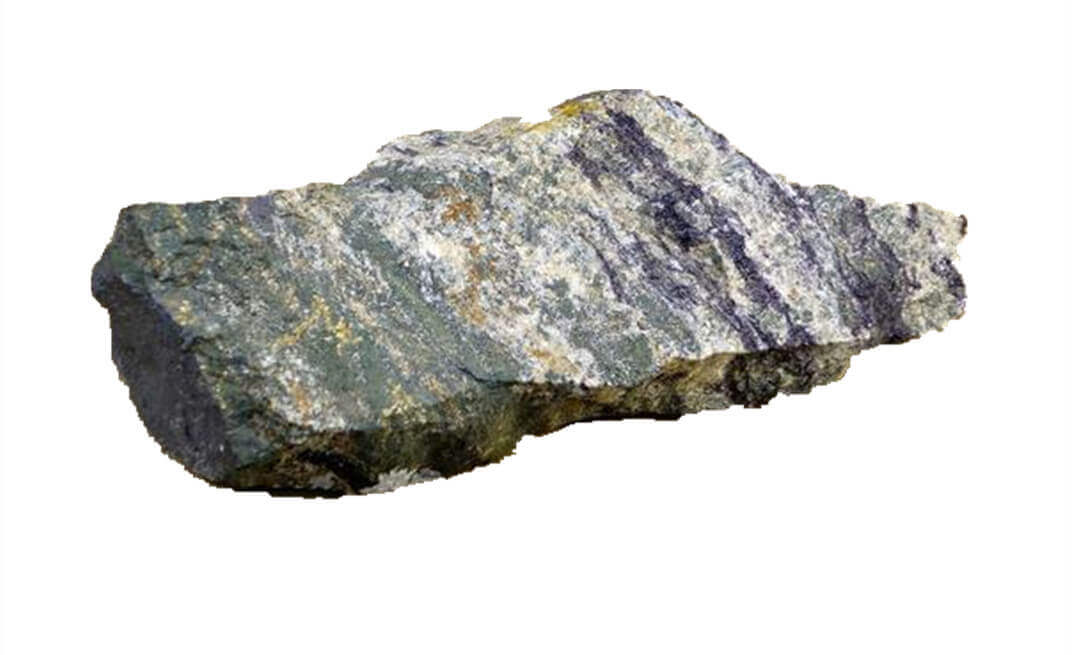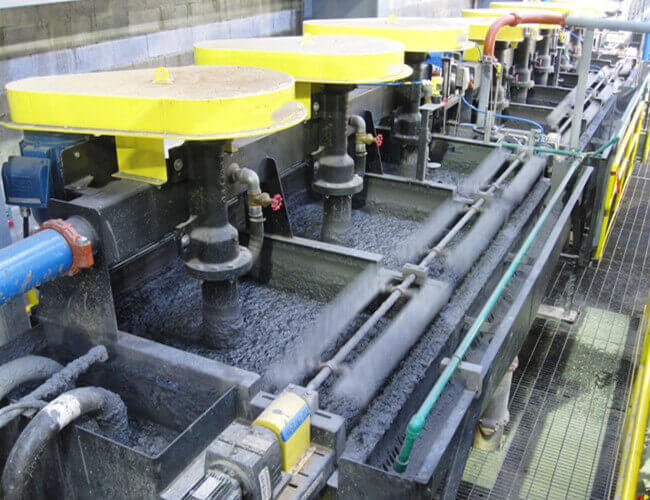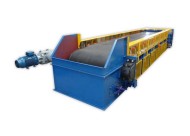Tantalum and niobium ore beneficiation generally use gravity separation for rough beneficiation, while gravity separation, flotation, electromagnetic separation, or a combined process of beneficiation and smelting are used for beneficiation to process ores with a high content of fine ore or native mud. Ore washing operations are indispensable, and at the same time, high-efficiency grinding and classification equipment reduce the mudification of tantalum and niobium minerals.
Commonly used collectors for tantalum and niobium flotation include fatty acids, arsenic acids, phosphonic acids, hydroxamic acids, cationic collectors, etc. The environmental pollution and pharmaceutical cost issues of collectors are crucial. With the development of the chemical industry, pharmaceuticals with wide sources of raw materials, simple synthesis processes, easy biodegradation, good selectivity, non-toxic and harmless, and reasonable prices will continue to appear to meet the needs of tantalum and niobium concentrators.
What Are The Reagents Used For Tantalum-niobium Flotation?
Tantalum and niobium mineral resources are famous for being poor, fine miscellaneous, and difficult to separate. Although the current mineral processing technology has made great progress compared with the past, the recovery rate of mineral processing is still low. In recent years, many scholars at home and abroad have conducted a lot of research work on tantalum and niobium flotation reagents. Among them, the more effective collectors include fatty acids, arsenic acids, phosphonic acids, hydroxamic acids, and cationic collectors.
1. Tantalum niobium mineral collector
- Fatty acid collectors
The former Soviet Union’s Polikin С И and Gradkikh Ю А used oxidized ore collectors including oleic acid, sodium oleate, sodium tri-decanoate, sodium alkyl sulfate, and sodium isobutyl phosphate in 1959 to study the floatability of columbite-tantalite, tourmaline, and garnet.
Tests show that when fatty acids are used as collectors, the collection ability of saturated hydrocarbon groups is worse than that of unsaturated ones. When the pH value is 6 to 8, flotation of columbite-tantalite with sodium oleate is extremely effective and is inhibited in both strongly acidic and alkaline media.
Modification of fatty acids can improve their selective capture properties. For example, new effective active groups such as the sulfonic acid, polycarboxyl, sulfate, halogen, amine (amino), aminoacyl, and amide groups are introduced into the molecule. - Arsonic acid collectors
Arsinic acid can form strong surface compounds with rare metal minerals such as tantalum and niobium, with the hydrocarbon groups facing outward, making the minerals hydrophobic. However, there is no such chemical adsorption with gangue minerals, so it has a strong collection ability and good selectivity. The disadvantage is that there are pollution problems in the production and use of arsine-containing substances. Benzylarsinic acid and toluenearsic acid are effective collectors for tantalum and niobium minerals, wolframite, and cassiterite. Mixing arsenic acid with xanthate can greatly improve the recovery rate of wolframite, cassiterite, tantalum, and niobium minerals. - Phosphonic acid trapping agents
The solubility of phosphonic acid in aqueous solution changes with the change of pH value. Generally, it has good solubility in an alkaline medium. It is dissolved by forming alkali metal salt. Phosphonic acid forms insoluble salts with metal ions such as Ca2+, Fe2+, Fe3+, Sn2+, etc., so it can capture tantalum and niobium minerals.
Research on the use of bisphosphonic acid to collect niobate rutile shows that when the pH value of the slurry is 2 to 4, bisphosphonic acid is a good collector of niobate rutile, with a recovery rate of 90.87% to 91.70%. Bisphosphonate acid is adsorbed on the surface of niobate rutile, and the adsorption form is mainly chemical adsorption. - Hydroxamic acid collectors
Hydroxamic acid and its salts were used in the early flotation of malachite and hematite and later used as collectors for various rare metal ores. Naphthalene hydroxamic acid has good selective collection performance for wolframite but has an extremely weak collection ability for quartz and fluorite. Using C7~9 hydroxamic acid to flotate yellow-green stone ore, the concentrate contains Nb2O5 6~20%, and the recovery rate is 65~66%. - Cation collector
In neutral media, cationic collectors are effective collectors for tantalum and niobium minerals; in strongly acidic media, the surfaces of tantalum and niobium minerals are mostly positively charged, which is not conducive to the flotation of cationic collectors; from the perspective of solution chemistry, The cationic collector undergoes hydrolysis reaction in aqueous solution. In a strongly alkaline medium, a large OH- concentration is not conducive to the hydrolysis reaction, and the cationic concentration of the collector decreases, which is detrimental to flotation. Brazil’s Araxa dressing plant uses amines as collectors to flotation pyrochlore and achieve good results. Other studies have shown that dodecyl amine acetate can effectively flotate columbite minerals in neutral media. - Other collectors
Research on the collection performance of tantalum and niobium minerals using the new agent N2 shows that high carbon chain N2 is an effective collector of tantalum and niobium minerals, and the adsorption on the surface of tantalum and niobium minerals is chemical adsorption. The flotation of Bayan Obo niobium ore using N-nitrosophenylhydroxylamine has achieved good results. The exploratory tests at Berger С in the former Soviet Union showed that hydrocarbyl sulfates are also suitable for the flotation of columbite-tantalite deposits in pegmatite deposits.
Many flotation agents, especially collectors, have less-than-ideal effects when used alone. However, when certain agents are used in combination in a certain proportion, the effect is not a simple additive effect, but synergistic. That is a 1 +1>2 synergy effect. For example, xanthate and hydroxamic acid are combined to flotation copper oxide; sodium oleate and hydroxamic acid are combined to float andalusite; arsenic acid is mixed with xanthate, cupferine is mixed with benzyl hydroxamic acid and benzo hydroxamic acid is mixed with Tal soap is mixed to flotation black tungsten fine mud; F203 and salicyl hydroxamic acid are mixed to flotation cassiterite fine mud and both achieve good results.
2. Tantalum-niobium ore flotation regulator
The main gangue minerals in tantalum-niobium ore are silicate, fluorite, and carbonate. Typical inhibitors of these minerals are water glass, sodium hexametaphosphate, starch, pyrophosphate, sodium hydrogen phosphate, sodium lignosulfonate, tannin, lactic acid, citric acid, tartaric acid, etc. The pH value has a great influence on the tantalum and niobium flotation process. Adjusters commonly used to adjust the pH value include sulfuric acid, hydrochloric acid, sodium hydroxide, soda, etc.
What Are The Problems With Tantalum-niobium Flotation Collectors?
There are several key issues in the flotation process of tantalum-niobium ore: the collector’s collector performance, environmental pollution of the collector, and the cost of chemicals. This issue will be explained below.
- The problem of collector performance
Molecules containing functional groups -COOH, -SO4H, and -SO3H have strong collection ability and poor selectivity and are only suitable for flotation of tantalum-niobium fine mud with simple mineral composition and quartz as the main gangue. The collection ability of hydroxamic acid on tantalum and niobium fine mud is weaker than that of fatty acids, but the selection is better. Phosphonic acid has a relatively strong ability to collect tantalum-niobium ore but is sensitive to Fe2+ and Ca2+ ions, which has a greater impact on the flotation process. - Environmental pollution and chemical cost issues of collectors
Arsinic acid can form strong surface compounds with metal minerals such as tantalum and niobium, with the hydrocarbon groups facing outward, making the minerals hydrophobic. However, there is no such chemical adsorption with gangue minerals, so it has a strong collection ability and good selectivity. At the same time, arsinic acid has It is insensitive to Ca2+ and Mg2+ ions and has strong adaptability to ores with high calcite content. However, arsinic acid is highly toxic and may cause environmental pollution. The regulator sodium fluosilicate or sodium fluoride used in conjunction with phosphonic acid and sulfosuccinic acid also has certain toxicity. In tantalum and niobium fine mud flotation, the dosage of chemicals used is large and the price is high; at the same time, some chemicals are highly toxic and require increased environmental protection expenses, thus increasing the cost of mineral processing. When hydroxamic acid flotation is used, the effect is better, but the dosage of chemicals is larger.
Many scholars at home and abroad have done a lot of work on the selection and development of tantalum and niobium flotation reagents, and have discovered many collectors with good selectivity. Although some progress has been made in the research on tantalum and niobium flotation reagents, due to the high price of reagents, only a few foreign niobium mines currently use flotation methods, such as the Oka mineral processing plant in Canada and the Alaxa mine in Brazil. As more and more refractory tantalum and niobium resources are developed, the demand for tantalum and niobium beneficiation agents with good selectivity and reasonable prices is expected to continue to increase.
LATEST PRODUCTS
Double Vibration Motor Feeder
【Capacity】30-300 t/h 【Feeding Size】0-550 mm …
Belt Feeder
【Capacity】 10-450 t/h 【Power】 1.5-2.5 kW/Mete…
Twin Screw Feeder
【Feeding Capacity】 10-160 t/h【Power】 2.2-…











